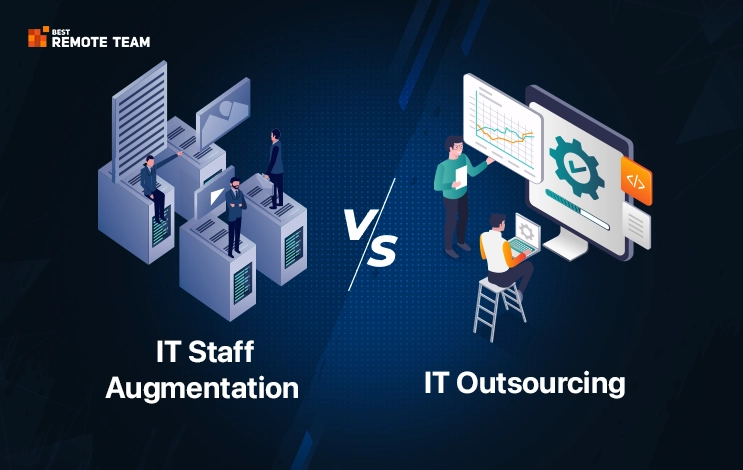What is IT Staff Augmentation?
This is a flexible business strategy where the businesses add IT professionals to the existing team without hiring them. This means you don’t need to outsource your entire project to another company; however, you can hire a few professionals without putting them on the payroll.
This strategy allows you to add some skilled professionals to your in-house team without the overhead or increased budget. Moreover, it allows you to stay in control of your business and project while managing temporary resources.
The global staffing industry reached $593 billion in revenue in the year 2023.
Types of IT Staff Augmentation
1. Short-term Augmentation
This strategy is used when you want to ramp up resources for a short period of time. As a strategy, it works perfectly when your current employee is on leave or you experience a peak in the workload. You can exhibit flexibility in scaling the teams without committing to long-term contracts.
2. Long-term Augmentation
In case you have an ongoing project or long-term software development, you might anticipate a need for professionals for an extended period. This model is more useful when you need resources integrated into your culture and processes.
Key Features of IT Staff Augmentation
- Staff augmentation services allow you to scale your resources up/down quickly, to meet the new project needs. this level of flexibility allows you to manage fluctuating workloads swiftly.
- Access specialized skills and technical experts without hiring the resources full-time for your in-house team. They can help meet the complex project needs and specific technical requirements.
- Accelerate the time to market your software project by assembling the core team with the requisite project understanding and skills.
- Have complete control over projects with the staff augmentation as the resources are an extended part of the team. This allows you to build a team that is aligned with your business goals.
- Reduce risks associated with outsourcing, such as control issues or communication barriers, which can help you deliver good solutions.
Advantages of IT Staff Augmentation
- Induces flexibility by scaling the IT team up or down based on project needs.
- Access specialized skills needed for your project that aren’t available in-house.
- Hire the professionals faster to your team to meet the tight deadlines.
- Gain complete control over your project and its quality with the right resources.
- On-board professionals for the specific project without any obligations.
- Seamlessly integrate the augmented staff with in-house teams to manage the continuity.
Cons of IT Staff Augmentation
- It will be difficult to align the augmentation staff with the in-house team owing to differences in culture and processes.
- You need additional effort to manage and coordinate the external expertise, which can lead to management overheads.
- Augmented staff lacks long-term commitment, which can cause retention issues when working with them.
Quick Read: Staff Augmentation Vs Dedicated Developers Team
What is Project Outsourcing?
IT outsourcing or project outsourcing is the strategy where you connect with external vendors to manage the specific IT functions or an entire project in detail. While these businesses handle your project, you focus on your core jobs.
In the case of IT outsourcing services, you will seek help in software development, IT management and data solutions. It helps you access global talent and leverage their specialization without owning an in-house team.
If you want to reduce operational costs or rapidly scale the operations, you can invest in IT outsourcing. When you select your partner, make sure to have clear communication with them and offer well-defined service-level agreements for best alignments.
Key Features of Project Outsourcing
- Access skilled and experienced professionals from across the globe to meet your outsourcing software development needs.
- Delegate the software tasks to external vendors or businesses to focus on core tasks, strategic solutions and primary operations.
- Reduce cost overheads by outsourcing app development projects to a seasoned service provider from low-cost regions.
- Offers clearly defined SLAs that set the pace for accountability and performance expectations from the service provider.
Advantages of IT Outsourcing
- Save on your overheads and expenses by outsourcing to regions that offer low hiring costs.
- Access talent from a wider pool as you can reach specialists from across geographies.
- Delegate your tasks to focus on core jobs to increase business productivity and operational efficiency.
- Scale your resources to meet the evolving project demand effortlessly.
- Manage and mitigate the risks of quality and delivery by adding communication protocols and established processes.
Cons of IT Outsourcing
- There is limited control over the outsourced processes, which can lead to misaligned goals.
- Differences in culture and time zones can cause communication barriers.
- There are security risks associated with data loss as external vendors are involved.
- You may experience quality and consistency issues, which can pose a challenge to your software project.
Key Differences Between IT Outsourcing and Staff Augmentation
We have compared the two IT operations strategies. IT outsourcing and staff augmentation across various factors.
#1 Control
IT Outsourcing: The entire software development project is delegated to an external vendor. They will manage the day-to-day operations and control the progress.
Staff Augmentation: The in-house team is extended by adding a few professionals on a contract basis. This allows the professionals to integrate with the team, allowing complete control of the in-house team.
#2 Cost Structure
IT Outsourcing: In this scenario, you will be hiring a contractor on a retainer or fixed-price basis. There would be additional costs associated with the add-on services, which are mentioned in the contract.
Staff Augmentation: The costs are variable and depend on the number of professionals you will add to the project. It also depends on the duration of the engagement.
Quick Read: Hourly Rate vs Fixed Cost: Which is Best for Your Business?
#3 Flexibility
IT Outsourcing: The external team commands the project from start to finish. This means it is not very flexible for you to add resources or make changes to the scope.
Staff Augmentation: You can easily add resources, adjust the scope or arrange things in the project to suit your needs as the professionals are added to your in-house team.
#4 Risk Management
IT Outsourcing: There is a risk of working around misaligned goals when outsourcing the IT requirements. In this strategy, you work with a shared or transferred risk.
Staff Augmentation: The risks are normally with the company that is planning the software development. However, in this strategy, you may experience an oversight of critical tasks that can impact the work.
#5 Engagement Scope
IT Outsourcing: The strategy is specifically used when you want to outsource specific tasks, functions or projects for a longer term.
Staff Augmentation: This strategy focuses on adding specific skills or resources to the existing team to meet the current demand or project requirements.
#6 Integration
IT Outsourcing: The external vendors don’t integrate with your company’s internal team or processes. They operate independently.
Staff Augmentation: The external professionals work closely with the team. This means they are attached to the processes and culture. They are completely integrated.
#7 Focus
IT Outsourcing: This strategy works perfectly when you are managing non-core projects. This lets you have enough time to handle core jobs while the outsourcing partner works on the non-core jobs.
Staff Augmentation: This strategy is typically used when you need to add more capacity to your team or work around specialized skills.
Staff augmentation Vs IT outsourcing – Which Engagement Model Should You Choose?
Staff augmentation offers you flexibility when you need to scale your teams up or down based on the project needs. moreover, it offers complete control and oversight of the project, allowing you to get an entire glimpse into what can happen.
Next, as it is integrated into your existing team, it facilitates smooth operations. It is cost-efficient when you are working with smaller projects. However, if you need them for a longer project, you may need to pay a higher price.
IT outsourcing, on the other hand, can make it easier to handle routine tasks cost-efficiently. You will be hiring remote development team as a retainer, which can ensure effectiveness. Moreover, the team comes with a fixed price or milestone-based contract.
Their entire focus is on your project, and they directly control the projects. They may have SLAs in place for accountability and transparency.
You must go with IT outsourcing if you are looking for a long-term engagement with crucial project demands. However, IT staff augmentation works best when you have limited scope and need to extend the in-house team.
Conclusion
The choice between staff augmentation companies and an outsourcing company for your project depends on the requirements, budget and specific goals. It also helps knowing if you are hiring the services for your core or non-core jobs.
Staff augmentation services offer flexibility and control while outsourcing makes the project cost-efficient and flexible. You can outsource core jobs for a longer term via outsourcing while going with staff augmentation for shorter projects.
Best Remote Team will support your hiring strategies with the best dedicated professionals and team. Our fully-defined process sources and vets the best resources to help you manage your projects and deliver them successfully.






